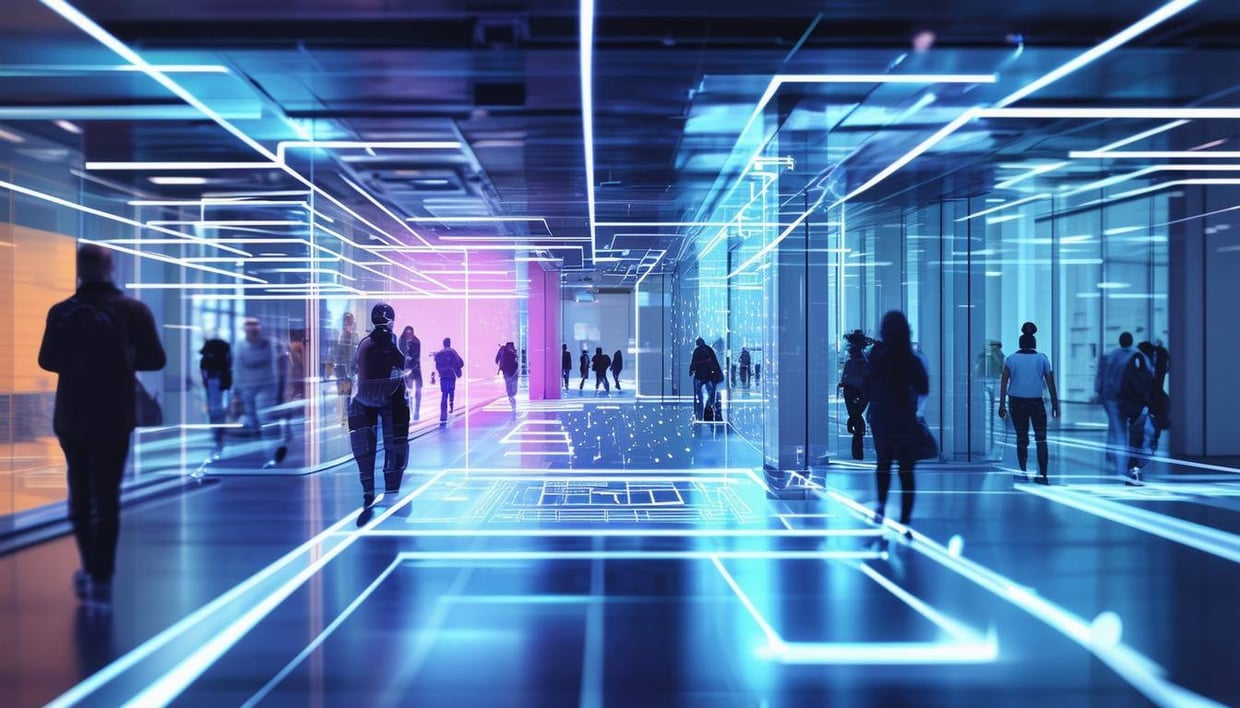< Back to the AR Wayfinding Guide
The 5 AI Features That Could Shape The Future Of AR Wayfinding
Like phonebooks and DVDs, getting lost will soon be a thing of the past. Paired with artificial intelligence, AR wayfinding will take indoor navigation to levels previously beyond our imagination - predicting your needs before they occur to you, adapting to your most intricate emotions, and even collaborating with others in real-time.
This article explores 5 ways that emerging AI innovations could supercharge AR wayfinding to revolutionize how we navigate indoor spaces in the near future.

1. Federated Learning
Federated learning is an AI approach where machine learning models are trained across decentralized devices while keeping data localized. While primarily researched for privacy-sensitive fields like healthcare and finance, it could revolutionize AR wayfinding by enabling systems to learn and optimize collaboratively without compromising user privacy.
Integration Potential:
- AR devices could use federated learning to improve navigation algorithms by sharing insights gleaned from users' experiences without transferring raw data. For example, if a shopping mall installs AR wayfinding, federated learning could allow devices to learn the most efficient routes over time, based on collective user data, while keeping individual movements private.
- This could also enable large-scale optimization of traffic flows in cities, airports, or campuses, dynamically improving routes without centralizing sensitive data.
2. Adaptive Visuals
Generative AI, best known for creating text, images, and videos, could enhance AR wayfinding by generating dynamic, context-aware visual or audio cues on-the-fly. Currently, AR navigation relies on pre-designed assets and overlays, but generative AI could create personalized and situational visuals in real time.
Integration Potential:
- Dynamic Signage: Imagine entering an unfamiliar building and seeing customized, context-relevant signs generated on demand by AI, displayed via AR. These signs could adapt their appearance, size, and language based on the user’s preferences or cultural background.
- Augmented Assistance: Generative AI could simulate realistic avatars or virtual assistants embedded within AR systems. These assistants could offer real-time verbal guidance or provide helpful instructions, such as how to navigate a tricky intersection or assemble an IKEA product using contextual cues.
3. Reinforcement Learning
Reinforcement learning (RL), which enables systems to learn optimal strategies through trial and error, has been making waves in robotics and autonomous systems. In AR wayfinding, RL could be employed to refine navigation strategies based on constantly changing environments.
Integration Potential:
- AR navigation systems could leverage RL to adapt routes in real-time based on user actions and environmental shifts. For instance, if a user hesitates at a suggested turn or encounters a blocked hallway, the system could learn from this and adjust future recommendations.
- RL could also enable autonomous systems like delivery drones or robots to navigate alongside humans in shared spaces, dynamically updating their paths to ensure safe and efficient navigation.
4. Affective Computing
Affective computing, or Emotion-AI, uses machine learning to analyze facial expressions, voice tones, or physiological signals to detect emotional states. While currently used in customer service and healthcare, it could significantly enhance AR wayfinding by providing stress-sensitive guidance.
Integration Potential:
- Stress-Adaptive Routes: AR systems could detect when a user feels overwhelmed, frustrated, or anxious—perhaps in a crowded airport or during a traffic jam—and adapt guidance accordingly. For instance, it could offer a quieter, less direct route or display calming visuals to ease navigation.
- Emotional Context Overlays: Emotion AI could enable AR wayfinding to provide context-sensitive recommendations, like pointing out nearby relaxation spots such as lounges, quiet zones, or green spaces, based on the user’s emotional state.
5. Digital Twins
Digital twins, virtual models of physical environments, are increasingly used in urban planning and industrial settings. Coupled with AI, digital twins could serve as real-time maps that anticipate environmental changes and guide AR systems to adapt dynamically.
Integration Potential:
- AR wayfinding could sync with a digital twin of a city or facility to predict congestion, detect obstacles, and provide routes based on the most up-to-date conditions.
- For example, at a theme park, a digital twin could model the flow of visitors and suggest routes that minimize wait times or avoid crowded attractions.
A Glimpse into the Future
By blending these AI innovations into AR wayfinding, our indoor navigation systems could evolve into intuitive companions that think, adapt, and respond in real-time. This isn’t just about finding the fastest route—it’s about guiding users with thoughtful, human-centered journeys that transform how we connect with our environments and each other.
Such AR experiences, once people are accustomed to them, would become as indispensable as online experiences have proven to be since the inception of the internet. For AR, it's not a matter of if, but when.
Updated on March 14, 2025
by Joshua Simpson


